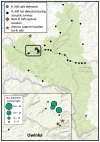Rediscovery of the critically endangered Hill's horseshoe bat (Rhinolophushilli) and other new records of bat species in Rwanda
- PMID: 36761632
- PMCID: PMC9848553
- DOI: 10.3897/BDJ.10.e83546
Rediscovery of the critically endangered Hill's horseshoe bat (Rhinolophushilli) and other new records of bat species in Rwanda
Abstract
Background: For forty years, there has been growing uncertainty about whether Hill's horseshoe bat (Rhinolophushilli) still persists in Nyungwe National Park, Rwanda. Only known from one small area within the National Park, R.hilli is listed as Critically Endangered by the International Union for the Conservation of Nature (IUCN), based on its extremely small geographic range and presumed low number of mature individuals. Here, we present and describe bat species occurrence data contributed to the Global Biodiversity Information Facility (GBIF) that we collected as part of a long-term collaborative project to rediscover this lost species. This data paper describes the survey methods and findings resulting from cave roost surveys, capture surveys, and acoustic sampling of bat echolocation activity in Nyungwe National Park and surrounding areas in south-western Rwanda from 2013-2020 and their conservation relevance.
New information: We report the discovery of an extant population of Hill's horseshoe bat (Rhinolophushilli) in Nyungwe National Park, Rwanda, 40 years since the last reported observation of the species in 1981. We also report the first record of Lander's horseshoe bat (Rhinolophuslanderi) in Nyungwe National Park and the first record of the Damara woolly bat (Kerivoulaargentata) in Rwanda. The dataset contributed to GBIF and described in this paper includes 278 occurrence records from 10 bat species of five families detected at 71 locations in or near Nyungwe National Park, Rwanda. We include a description of the morphological descriptions of R.hilli and present the first acoustic echolocation signatures and phylogenetic information for this species.
Keywords: Afromontane rainforest; Albertine Rift; Nyungwe National Park; Rwanda.
Jon Flanders, Winifred F Frick, Julius Nziza, Olivier Nsengimana, Prince Kaleme, Marie Claire Dusabe, Innocent Ndikubwimana, Innocent Twizeyimana, Sospeter Kibiwot, Pierre Ntihemuka, Tina L Cheng, Richard Muvunyi, Paul Webala.
Figures






Similar articles
-
A survey of the praying mantises of Rwanda, including new records (Insecta, Mantodea).Zootaxa. 2015 Oct 1;4027(1):67-100. doi: 10.11646/zootaxa.4027.1.3. Zootaxa. 2015. PMID: 26624167
-
A new species of Dystacta Saussure, 1871 from Nyungwe National Park, Rwanda (Insecta, Mantodea, Dystactinae).Zookeys. 2014 May 20;(410):1-21. doi: 10.3897/zookeys.410.7053. eCollection 2014. Zookeys. 2014. PMID: 24899847 Free PMC article.
-
Shifting through the forest: home range, movement patterns, and diet of the eastern chimpanzee (Pan troglodytes schweinfurthii) in Nyungwe National Park, Rwanda.Am J Primatol. 2018 Aug;80(8):e22897. doi: 10.1002/ajp.22897. Epub 2018 Jul 10. Am J Primatol. 2018. PMID: 29992652
-
Optimal allocation of law enforcement patrol effort to mitigate poaching activities.Ecol Appl. 2021 Jul;31(5):e02337. doi: 10.1002/eap.2337. Epub 2021 May 9. Ecol Appl. 2021. PMID: 33780061
-
A review of the major threats and challenges to global bat conservation.Ann N Y Acad Sci. 2020 Jun;1469(1):5-25. doi: 10.1111/nyas.14045. Epub 2019 Apr 2. Ann N Y Acad Sci. 2020. PMID: 30937915 Review.
Cited by
-
Genetic and Morphological Evidence From a Group of Rare African Free-Tailed Bats Reveals a New Subgenus Within Mops.Ecol Evol. 2025 May 14;15(5):e71288. doi: 10.1002/ece3.71288. eCollection 2025 May. Ecol Evol. 2025. PMID: 40370356 Free PMC article.
References
-
- Aellen V. Un Rhinolophus nouveau d’Afrique centrale. Periodicum Biologorum 1973
-
- Parks African. Nyungwe National Park. https://www.africanparks.org/the-parks/nyungwe. [2021-12-12T00:00:00+02:00]. https://www.africanparks.org/the-parks/nyungwe
-
- Baeten B., Van Cakenberghe V., De Vree F. An annotated inventory of a collection of bats from Rwanda (Chiroptera) Revue de Zoologie Africaine. 1984;98(1):183–196.
-
- Crawford A. The International Institute for Sustainable Development; 2012. Conflict-Sensitive Conservation in Nyungwe National Park: Conflict analysis .
-
- Csorba G., Ujhelyi P., Thomas N. Horseshoe bats of the world (Chiroptera: Rhinolophidae) Alana Books; Bishops Castle, Shropshire, UK: 2003. 160
